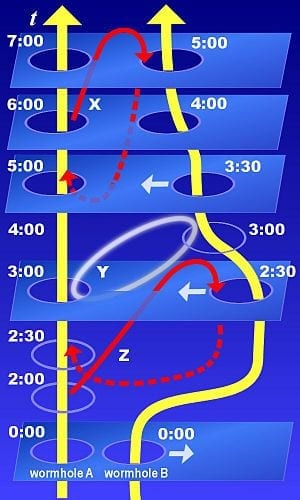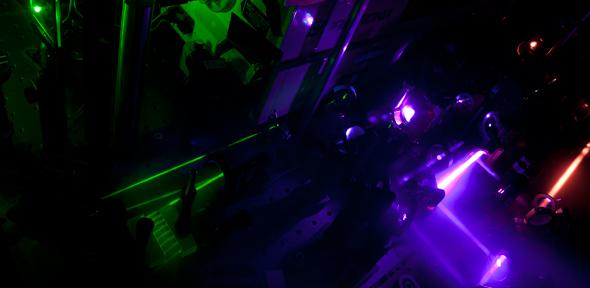
The new theory connects quantum entanglement with Einstein’s general relativity
Wormholes and entanglement—two of science fiction’s favorite concepts from modern physics—may in reality be two sides of the same coin, physicists say. The findings may offer a way to solve puzzling mysteries about black holes and perhaps help reconcile theories of gravity and quantum physics, which has been the dream of physicists since the mid–20th century.
Wormholes are hypothetical shortcuts through spacetime, also known as Einstein–Rosen bridges, after Albert Einstein and Nathan Rosen, who predicted them in 1935. Entanglement is another way of connecting two distant objects: When two particles are entangled, they retain a connection even when separated over great distances, so that actions performed on one affect the other. Entanglement has been demonstrated in quantum physics experiments with particles, but wormholes, which arise from general relativity, are purely theoretical. The two phenomena were long thought to be unrelated.
Then physicists Leonard Susskind of Stanford University and Juan Maldacena of the Institute for Advanced Study in Princeton, N.J. began to think about entangling two black holes to one another. Entanglement is generally thought to occur between tiny particles, not giant cosmic objects. But if two black holes were entangled, and then separated from one another, the result, the physicists reasoned, would be a wormhole connecting them. Susskind and Maldacena postulated such a link between wormholes and entanglement earlier this year.
Two independent teams have since found support for the idea. They show theoretically that entangled quarks are indeed connected by a wormhole within a stripped-down version of reality. In this model it’s as if the wormhole exists in our real 4-D world (three dimensions of space and one of time), but the quarks are entangled only in a flattened 3-D simulacrum of reality. (This kind of modeling is akin to using a two-dimensional hologram to represent a 3-D object.) “What Maldacena and Susskind want to say is that literally whenever you have entanglement, you have wormholes,” says Andreas Karch of the University of Washington, co-author of one of the two new papers.
The Latest on: Wormholes
[google_news title=”” keyword=”Wormholes” num_posts=”10″ blurb_length=”0″ show_thumb=”left”]
via Google News
The Latest on: Wormholes
- Date A Live: 10 Strongest Spirits, Rankedon May 2, 2024 at 12:59 am
The Spirits that appear before Shido in Date A Live each have their own set of abilities, with some being much more powerful than others.
- Doris Duke Foundation In Partnership With Building Bridges Fellowship & Completion Fund Grant $1M To Sundance Institute In Commitment To Uplift Muslim Storytellingon April 26, 2024 at 5:00 am
EXCLUSIVE: The Doris Duke Foundation is pleased to announce its continued commitment to uplifting Muslim stories through a $1 million grant to Sundance Institute. Through a three-year commitment, the ...
- Embark on galactic adventures with these space opera bookson April 26, 2024 at 4:18 am
Seldon's goal is to save knowledge and culture as the Galactic Empire faces decline. This influential series tackles profound themes, including the tension between free will and determinism, and the ...
- Pokemon Fan Creates Fusion Art of Vaporeon and Blacephalonon April 25, 2024 at 2:53 pm
A talented fan artist creates a new Pokemon by imagining a fusion of the Water-type Vaporeon with the Fire/Ghost-type Blacephalon.
- Michigan’s morel mushroom season: Where to find them and how to identify themon April 25, 2024 at 5:01 am
Morel mushroom foraging season lasts long, beginning in mid-April and continuing through mid-June. Hunters in southern Michigan may start to see them earlier in the season while hunters in the Upper ...
- Quantum mechanical wormholes fill gaps in black hole entropyon April 25, 2024 at 4:58 am
A new theoretical model could solve a 50-year-old puzzle on the entropy of black holes. Developed by physicists in the US, Belgium and Argentina, the model uses the concept of quantum-mechanical ...
- From a Doctor Strange nod to a dark Ant-Man cameo, here's every Easter egg in the new Deadpool 3 traileron April 23, 2024 at 4:41 am
While it's still not been confirmed that Emma Corrin's villain is, in fact, Professor X's evil twin sister Cassandra Nova, it seems pretty undeniable now that she'll be the one making Deadpool and ...
- John Oliver Uncovers the Totally Rational Explanations for UFOson April 21, 2024 at 11:00 pm
HBOOrdinary Americans, military pilots, and even former President Jimmy Carter have claimed to have seen unidentified flying objects in the sky over the past 77 years, and on Sunday night, John Oliver ...
- Wormholes and Black Holes: Bridging the Gap in Space-Timeon April 19, 2024 at 9:50 am
In the vast expanse of the cosmos, where the laws of physics stretch beyond our comprehension, black holes and wormholes stand as two of the most enigmatic and intriguing phenomena. While black holes ...
- Watch bizarre moment glowing UFO ‘flies into active volcano’ that researcher claims is a ‘wormhole’ for alien spacecrafton April 19, 2024 at 8:22 am
AN eerie footage shows UFO flying into an active volcano that allegedly serves as an interdimensional portal to Earth. A bright shining object could be seen flying towards a Popocatepetl volcano ...
via Bing News









